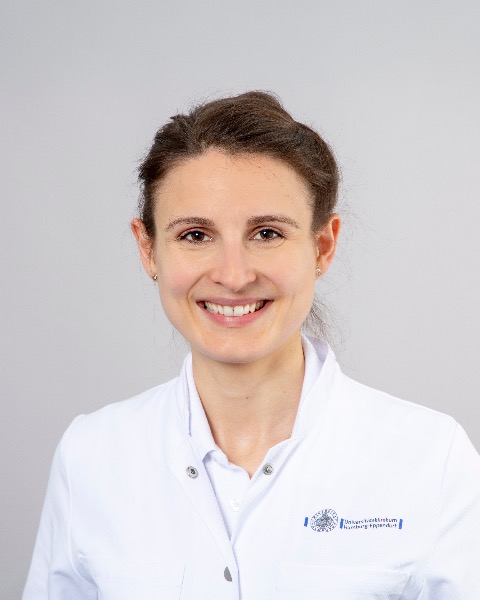Oral Abstract Session
OA – 53: Isa-KRd in High-Risk Newly Diagnosed Multiple Myeloma – 4-Year-Follow-Up from the GMMG-CONCEPT trial
Wednesday, September 25, 2024
12:18 PM - 12:30 PM East Coast USA Time
Location: 101 A1-A2, Convention Center

Lisa B. Leypoldt, MD (she/her/hers)
Clinician Scientist/ Research Fellow
University Medical Center Hamburg-Eppendorf, Germany / Dana-Farber Cancer Institute, Boston, MA, USA
Hamburg, Germany
Speaker(s)
Introduction: High-risk (HR) multiple myeloma (MM) patients (pts) continue to show impaired survival compared to standard risk pts with newly diagnosed (ND) disease and are therefore in need of novel effective treatment options. The academic, multi-center phase II GMMG-CONCEPT trial (NCT03104842) investigates the quadruplet isatuximab, carfilzomib, lenalidomide, and dexamethasone (Isa-KRd) in ND HR MM both transplant-eligible (TE) and ineligible (TNE) pts. Interim analysis showed high rates of minimal residual disease (MRD) negativity (neg), with the trial meeting its primary endpoint of MRD neg at the end of consolidation (67.7% [TE] and 54.2% [TNE]), and 2-year (Y)-progression-free-survival (PFS) rates of 78.3% (TE) and 62.6% (TNE). Here, we report longer-term outcomes of the first cohort with a ≥4-Y-follow-up for survival and MRD neg.
Methods: HR MM was defined by ISS stage 2 or 3 and any of del17p, t(4;14), t(14;16), or >3 copies 1q21 (amp1q21). Isa-KRd induction (6 cycles), high-dose therapy (for TE pts) or 2 cycles of Isa-KRd (for TNE pts), and consolidation (4 cycles) are followed by 2 years of Isa-KR maintenance. MRD is centrally assessed by next-generation flow with a sensitivity level of 10-5. Data cutoff was 11.04.2024.
Results:
The first cohort included in total 153 pts (127 TE, 26 TNE) with a median age of 59 (TE) and 74 years (TNE); del17p and t(4;14) were the most common HR cytogenetic aberrations. With a median follow-up (mFU) of 54 months for TE pts, PFS-rates at 4, 5, and 6 years (Y) were 59.4% (51.2-68.9), 52.8% (43.6-64.1), and 52.8% (43.6-64.1), respectively. Four-year-overall-survival (OS)-rate was 72.3% (64.8-80.7); 5-Y- and 6-Y-OS-rates were 67.8% and 61.6%, respectively. In TNE patients (mFU of 51 months), 4-Y- and 5-Y-PFS-rates were both 54.3% (37.6-78.3) with 4-Y- and 5-Y-OS-rates of 65.9% each (49.1-88.4).
Achievement of MRD neg conferred significant benefit in PFS for TE pts (hazard ratio [hr] 0.34 [0.13;0.88]; multivariable time-dependent Cox regression) which became even more pronounced for pts remaining in MRD-neg state (hr 0.11 [0.05;0.28]).
Of 106 TE pts achieving MRD neg on study (83.5%), 85 pts had ≥1-Y-sustained MRD neg (80.2%). First MRDneg assessments of pts with ≥1-Y-sustained MRD neg occurred early on, during induction in 53 pts (62.4%), intensification in 12 pts (14.1%), consolidation in 18 pts (21.2%), and during maintenance in 2 pts (2.4%). For 18 TNE pts with MRD-negative results (69.2%), ≥1-Y-sustained MRD negativity was reported in 13 pts (72.2%) with their first MRD-negative assessment during induction in 7 (53.8%) or during consolidation in 6 (46.2%) pts.
Conclusions:
These data from our CONCEPT trial underline the high potency of Isa-KRd to not only induce but also maintain MRD neg remissions in HR NDMM pts irrespective of transplant status. Six years after treatment initiation, more than half of these HR pts are still alive and progression-free.
Funding and IMP: Sanofi, Amgen, and BMS/Celgene
Methods: HR MM was defined by ISS stage 2 or 3 and any of del17p, t(4;14), t(14;16), or >3 copies 1q21 (amp1q21). Isa-KRd induction (6 cycles), high-dose therapy (for TE pts) or 2 cycles of Isa-KRd (for TNE pts), and consolidation (4 cycles) are followed by 2 years of Isa-KR maintenance. MRD is centrally assessed by next-generation flow with a sensitivity level of 10-5. Data cutoff was 11.04.2024.
Results:
The first cohort included in total 153 pts (127 TE, 26 TNE) with a median age of 59 (TE) and 74 years (TNE); del17p and t(4;14) were the most common HR cytogenetic aberrations. With a median follow-up (mFU) of 54 months for TE pts, PFS-rates at 4, 5, and 6 years (Y) were 59.4% (51.2-68.9), 52.8% (43.6-64.1), and 52.8% (43.6-64.1), respectively. Four-year-overall-survival (OS)-rate was 72.3% (64.8-80.7); 5-Y- and 6-Y-OS-rates were 67.8% and 61.6%, respectively. In TNE patients (mFU of 51 months), 4-Y- and 5-Y-PFS-rates were both 54.3% (37.6-78.3) with 4-Y- and 5-Y-OS-rates of 65.9% each (49.1-88.4).
Achievement of MRD neg conferred significant benefit in PFS for TE pts (hazard ratio [hr] 0.34 [0.13;0.88]; multivariable time-dependent Cox regression) which became even more pronounced for pts remaining in MRD-neg state (hr 0.11 [0.05;0.28]).
Of 106 TE pts achieving MRD neg on study (83.5%), 85 pts had ≥1-Y-sustained MRD neg (80.2%). First MRDneg assessments of pts with ≥1-Y-sustained MRD neg occurred early on, during induction in 53 pts (62.4%), intensification in 12 pts (14.1%), consolidation in 18 pts (21.2%), and during maintenance in 2 pts (2.4%). For 18 TNE pts with MRD-negative results (69.2%), ≥1-Y-sustained MRD negativity was reported in 13 pts (72.2%) with their first MRD-negative assessment during induction in 7 (53.8%) or during consolidation in 6 (46.2%) pts.
Conclusions:
These data from our CONCEPT trial underline the high potency of Isa-KRd to not only induce but also maintain MRD neg remissions in HR NDMM pts irrespective of transplant status. Six years after treatment initiation, more than half of these HR pts are still alive and progression-free.
Funding and IMP: Sanofi, Amgen, and BMS/Celgene